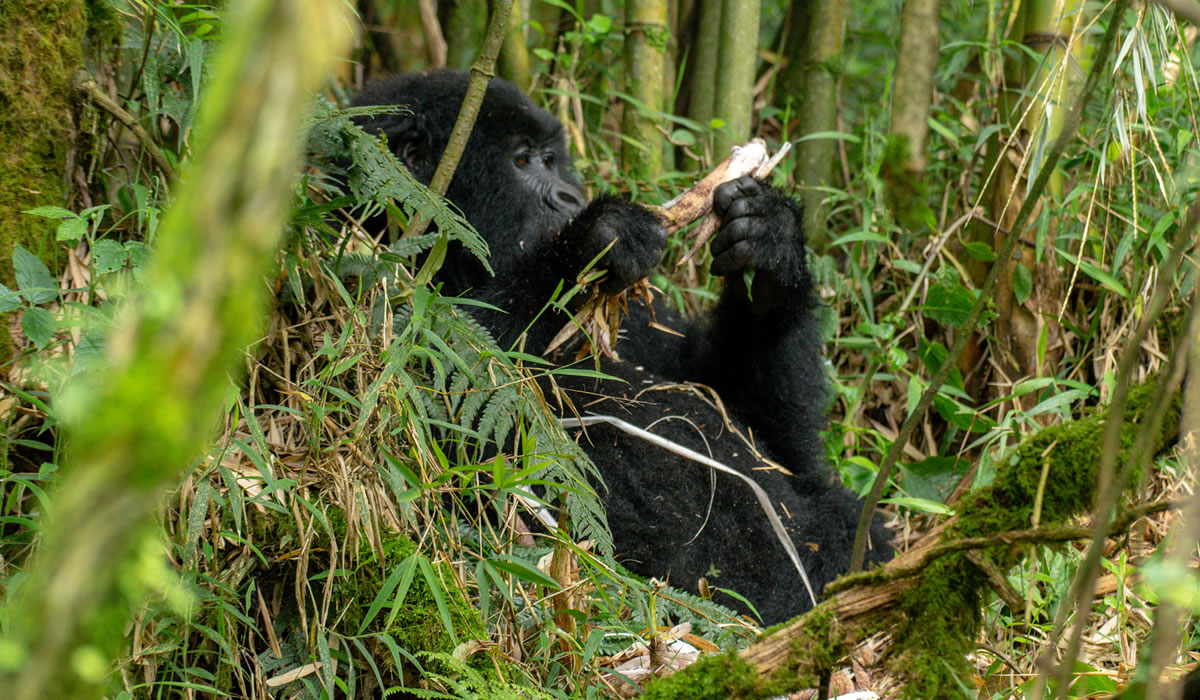Mgahinga Gorilla National Park, located in southwestern Uganda along the borders of Rwanda and the Democratic Republic of Congo, is one of the country’s most captivating and biologically rich protected areas. Covering an area of just 33.7 square kilometers, it is the smallest national park in Uganda, yet it holds immense ecological and cultural significance. The park is part of the larger Virunga Conservation Area, famous for its critically endangered mountain gorillas. Mgahinga is renowned for its dense montane forests, volcanic peaks, bamboo forests, and unique wildlife, making it a must-visit destination for travelers seeking gorilla trekking, birdwatching, hiking, and authentic nature experiences.

The Volcanoes and Scenic Landscapes
Mgahinga Gorilla National Park is dominated by three extinct volcanic mountains: Mount Sabinyo, Mount Gahinga, and Mount Muhabura. These volcanoes form a dramatic backdrop to the park and are a major attraction for trekkers and photographers. The montane forests and bamboo zones covering these mountains provide a unique ecosystem that supports a variety of wildlife and plant species.
The park’s rolling hills, volcanic craters, and valleys are interspersed with rivers, streams, and swampy areas, creating a rich mosaic of habitats. Hiking to the peaks of these mountains offers breathtaking panoramic views of the Virunga landscape, Lake Mutanda, and neighboring national parks in Rwanda and Congo. Mount Sabinyo, with its distinctive triple summit, is considered sacred by the local communities and is a popular trekking destination for experienced hikers seeking challenging and rewarding adventures.
Wildlife in Mgahinga Gorilla National Park
Mgahinga Gorilla National Park is famous for its population of mountain gorillas, one of the most critically endangered species in the world. Gorilla trekking in the park allows visitors to spend an hour observing these gentle giants in their natural habitat. Guided treks, led by trained rangers, provide insights into gorilla behavior, social structures, and the park’s conservation efforts. Encounters with gorillas are deeply moving, offering a once-in-a-lifetime wildlife experience.
In addition to gorillas, Mgahinga is home to golden monkeys, another primate species endemic to the Virunga region. Golden monkey trekking provides visitors with the chance to observe these playful and colorful primates in bamboo forests, a unique activity that complements the gorilla trekking experience. Other primates in the park include black-and-white colobus monkeys, vervet monkeys, and olive baboons, which inhabit the montane forests and add to the park’s biodiversity.
Mgahinga also supports a variety of ungulates, including bushbucks, duikers, and forest antelopes. Birdlife is exceptionally diverse, with over 180 species recorded in the park. Birdwatchers can spot species such as the Rwenzori turaco, African green broadbill, mountain illadopsis, and various sunbirds, warblers, and hornbills. Raptors, including the African harrier-hawk and augur buzzard, soar over the volcanic peaks, creating thrilling sightings for wildlife enthusiasts and photographers.
Activities in Mgahinga Gorilla National Park
Mgahinga Gorilla National Park offers a range of activities for adventure seekers, wildlife enthusiasts, and nature lovers.
Gorilla Trekking
Gorilla trekking is the park’s most popular activity. Visitors must obtain permits from the Uganda Wildlife Authority, which are limited to ensure minimal disturbance to the gorillas. Treks typically start early in the morning and can last anywhere from two to five hours, depending on the location of the gorilla families. Spending an hour observing gorillas in their natural environment is an unforgettable experience, offering the chance to witness their feeding, playing, grooming, and social interactions.
Golden Monkey Trekking
Golden monkey trekking is another highlight of Mgahinga. These primates are often seen in bamboo zones, leaping and feeding in groups. The trek is moderately challenging and is suitable for most visitors, offering both wildlife encounters and scenic forest hikes. The golden monkeys’ vibrant colors and playful behavior make for excellent photography opportunities.
Hiking and Volcano Climbing
Hiking to the peaks of Mount Sabinyo, Mount Gahinga, and Mount Muhabura is a rewarding activity for adventurers. Trails pass through montane forests, bamboo groves, and open grasslands, offering varied scenery and wildlife sightings along the way. Mount Muhabura, the highest of the three volcanoes, provides panoramic views over the surrounding Virunga landscape and is a favorite for seasoned hikers seeking a challenging trek.
Nature Walks and Birdwatching
Guided nature walks in Mgahinga allow visitors to explore the park’s forests, valleys, and streams at a leisurely pace. Walks focus on spotting birds, primates, insects, and rare plants, providing an educational and immersive experience. Early morning walks are ideal for birdwatching, as many species are most active during these hours.
Cultural Experiences
Mgahinga is located near communities of the Batwa and Bakiga people. Visitors can engage in cultural experiences, learning about traditional lifestyles, crafts, and rituals. The Batwa, who were traditionally forest dwellers, offer storytelling, music, and cultural tours that provide insights into their heritage and connection to the forest. Cultural tourism helps support local communities while preserving traditional knowledge and practices.
Scenic Photography
The park’s landscapes, wildlife, and cultural encounters provide endless opportunities for photography. From volcanic peaks and misty forests to gorillas, golden monkeys, and colorful bird species, photographers will find Mgahinga a visual paradise. Sunrise and sunset offer particularly dramatic lighting, enhancing the natural beauty of the park.
Accommodation in Mgahinga Gorilla National Park
Mgahinga Gorilla National Park offers a variety of accommodation options to suit different preferences and budgets. Luxury lodges such as Mount Gahinga Lodge, Bwindi Mgahinga Safari Lodge, and Nkuringo Gorilla Lodge provide elegant rooms, fine dining, and organized safari activities. Mid-range lodges and camps like Mahogany Springs Lodge and Mgahinga Gorilla Camp offer comfortable stays with convenient access to gorilla trekking and hiking trails. Budget travelers can find community-run campsites and guesthouses in Kisoro town or near the park entrance, providing affordable lodging while supporting local livelihoods.
Many lodges are strategically located near park entrances, gorilla trekking starting points, or scenic viewpoints, allowing easy access to activities and stunning vistas of the Virunga landscape. Accommodation often emphasizes eco-friendly practices and sustainability, minimizing impact on the park’s fragile ecosystems.
Best Time to Visit Mgahinga Gorilla National Park
Mgahinga Gorilla National Park can be visited year-round, but the dry seasons, from December to February and June to September, are ideal for gorilla trekking, golden monkey tracking, and hiking. Trails are more navigable during these months, and wildlife is easier to spot.
The wet seasons, from March to May and October to November, bring lush greenery, misty forests, and active waterfalls, creating spectacular scenery. While trekking during the wet season can be more challenging due to muddy trails, the park’s biodiversity and vibrant forest landscapes are at their peak, making it a rewarding time for nature enthusiasts and photographers.
Getting to Mgahinga Gorilla National Park
Mgahinga Gorilla National Park is approximately 520 kilometers southwest of Kampala. Travelers can reach the park by road, typically taking 8 to 10 hours, passing through scenic landscapes, tea plantations, and small towns. Kisoro town serves as the main gateway to the park, with most lodges and trekking starting points located nearby.
For quicker access, domestic flights are available from Entebbe International Airport or Kajjansi Airfield to Kisoro Airstrip. Flights provide scenic aerial views of the Virunga mountains, the park, and surrounding lakes, adding an extra dimension to the safari experience.
Conservation and Community Engagement
Mgahinga Gorilla National Park is managed by the Uganda Wildlife Authority in collaboration with the Uganda Community Tourism Association. Conservation initiatives focus on protecting mountain gorillas, golden monkeys, and other endangered species while preserving the montane forest ecosystem. Anti-poaching patrols, forest restoration programs, and environmental education campaigns are central to the park’s conservation strategy.
Community involvement is integral to the park’s success. Local communities, particularly the Batwa and Bakiga, benefit from tourism through employment, cultural tourism initiatives, and revenue-sharing programs. Visitors are encouraged to support responsible tourism practices, such as staying at eco-friendly lodges, engaging with local guides, and purchasing community-made crafts. These efforts contribute to sustainable conservation and the livelihoods of people living around the park.
Mgahinga Gorilla National Park is a jewel of Uganda’s protected areas, offering an unparalleled combination of wildlife, scenic landscapes, cultural experiences, and adventure activities. From observing critically endangered mountain gorillas and playful golden monkeys to hiking volcanic peaks, exploring bamboo forests, and birdwatching in pristine montane ecosystems, Mgahinga provides unforgettable experiences for travelers of all interests.
Its small size, relative remoteness, and ecological significance make it a uniquely intimate safari destination. Whether you are a seasoned adventurer, wildlife enthusiast, photographer, or nature lover, a visit to Mgahinga Gorilla National Park promises memories that will last a lifetime. The park’s commitment to conservation, community engagement, and sustainable tourism ensures that both visitors and local people benefit while preserving this extraordinary corner of Uganda for future generations.

